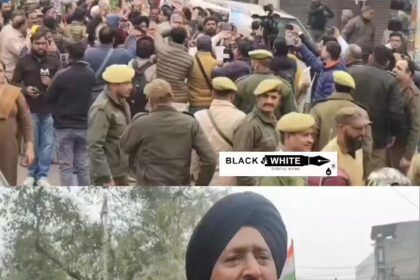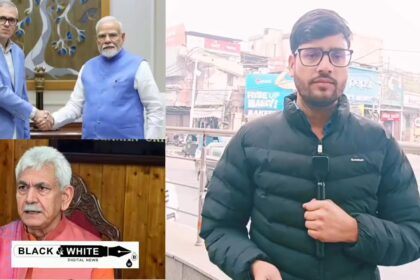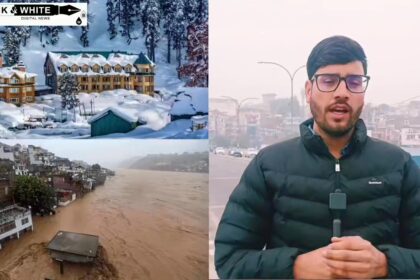Protest Led by Vikram Randhawa to halt construction of Blind Walls; Threats for Mass Agitation.
Top BJP Leaders of Jammu on Silent Mode over the Issue.
Congress Leaders in Sleep Mode.
|| Black and White Digital News||
||Parvinder Singh June 27,2024 ||
Jammu : In a renewed wave of dissent, significant protests have once again erupted in Jammu against the National Highways Authority of India’s (NHAI) decision to erect blind walls along the Kunjwani to Narwal stretch. This proposed construction has sparked widespread outrage among local shopkeepers, educational institutions, medical facilities, and other businesses, who foresee devastating impacts on their operations and accessibility.
Leading the protest, former BJP Member of Legislative Council (MLC) Vikram Randhawa and prominent businessman Sham Langar vocally opposed their own party’s government, demanding an immediate halt to the project. Joined by a substantial number of affected stakeholders, they voiced their concerns over the lack of consultation and transparency in the project’s Detailed Project Report (DPR).
Shopkeepers and business owners are particularly incensed, arguing that the blind walls will obstruct visibility and access to their establishments, leading to a sharp decline in customer footfall and subsequent revenue losses. Schools and hospitals along the route have also raised alarms about the potential hazards and inconveniences the walls could pose, including restricted emergency access and decreased safety for students and patients.
Randhawa and Langar underscored the glaring omission of stakeholder consultation in the planning process. They emphasized the necessity for NHAI and the government to engage with local businesses and residents before finalizing infrastructural projects that have wide-ranging implications. The leaders questioned the rationale behind the decision-making process, suggesting that the current plan appears to prioritize vehicular movement over the livelihoods and safety of the local community.
In a fiery address to the gathering, Randhawa issued a stern warning to the authorities. He declared that if the project was not scrapped, they would mobilize a mass agitation, potentially escalating the protest to a statewide movement. “We will not stand by as our businesses are destroyed and our voices ignored. This blind wall project must be dropped immediately, or we will take to the streets in greater numbers,” he asserted.
The protestors have called on the government to reassess the project, taking into account the adverse effects on the local economy and daily life. They urged for a collaborative approach where the voices of those directly impacted are heard and their concerns addressed.
The protest brings to light the ongoing internal conflicts within the BJP. Last year, Randhawa was embroiled in a tussle with Union Minister Dr. Jitendra Singh over mining issues. Despite these internal conflicts, no other BJP leaders have raised their voices against the blind wall project, leaving Randhawa as the sole dissenting voice within the party.
In an attempt to mediate, BJP National General Secretary Tarun Chugh arranged a meeting between Randhawa and Union Minister for Road Transport and Highways Nitin Gadkari to discuss the blind wall issue. Dr. Jitendra Singh attended the meeting, but no resolution was reached, and NHAI continues its work according to the original DPR.
The renewed protests raise broader political questions. Notably absent from the discussion are other prominent BJP leaders like Ravinder Raina and Kavinder Gupta. Their silence has fueled speculation about Randhawa’s motivations, with some suggesting he might be positioning himself as a potential candidate for the upcoming assembly elections.
Questions also surround the muted response from Congress leaders, who have remained conspicuously silent on the issue. This has left many wondering about the political calculations at play and why more voices aren’t joining the outcry against a project that seems widely unpopular among local businesses and communities.
The situation remains tense as the affected parties await a response from NHAI and government officials. The unfolding events will test the administration’s willingness to balance infrastructure development with the needs and well-being of its citizens. As the community rallies together, the demand for a more inclusive and transparent planning process grows louder, setting a crucial precedent for future projects in the region.
The ongoing protests highlight a significant disconnect between governmental planning and the needs of the local populace, raising important questions about governance, representation, and public accountability. As the story develops, it will be essential to monitor how these tensions are navigated and resolved.
Leave a comment
You Might Also Like
The RSS Whose Ideology BJP Follows Did Not Hoist the Indian Flag at Its Office for 50 Years: T.S. Tony
The RSS Whose Ideology BJP Follows Did Not Hoist the Indian Flag at Its Office for 50 Years: T.S. Tony…
0 Min Read
CM Omar Abdullah Flags LG Manoj Sinha Interference in J&K Governance, Says Centre Supportive Except On Statehood
CM Omar Abdullah Flags LG Manoj Sinha Interference in J&K Governance, Says Centre Supportive Except On Statehood #OmarAbdullah #JammuAndKashmir #JKPolitics…
0 Min Read
Nashe Se Dour Rahe Sports Me Hisa Le Cabinet Minister Satish Sharma
Nashe Se Dour Rahe Sports Me Hisa Le Cabinet Minister Satish Sharma #SayNoToDrugs #DrugFreeYouth #StayAwayFromDrugs #ChooseSports #SportsForLife #HealthyYouth #FitIndia #YouthEmpowerment…
0 Min Read
Snowfall Likely in Higher Reaches of Kashmir; Rain Expected in Plains of J&K Till December 22: Meteorological Department Yeh Facebook ke liye SEO-friendly hashtags hain:
Snowfall Likely in Higher Reaches of Kashmir; Rain Expected in Plains of J&K Till December 22: Meteorological Department Yeh Facebook…
0 Min Read









